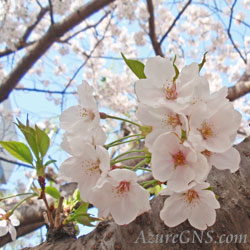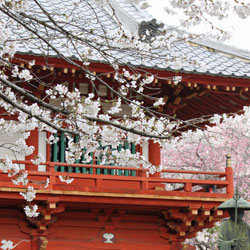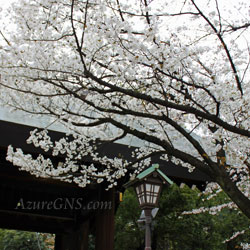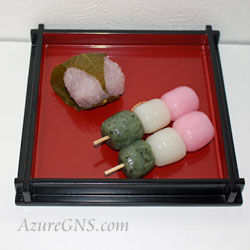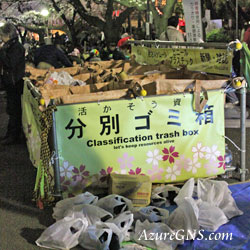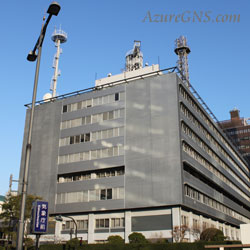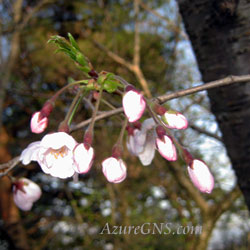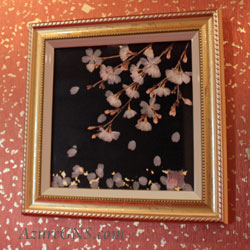(4月)
O-hanami;
Cherry Blossom Viewing
(April)
●花見 Hanami;
O-hanami (an honorific expression for Hanami);
Cherry Blossom Viewing
●桜 (木)cherry tree;
(花)cherry blossom
●枝垂れ桜 (木)weeping cherry tree
●八重桜 (木)double-flowered cherry tree;
(花)double cherry blossom
●山桜 (木)wild cherry tree;
(花)wild cherry blossom
●桜前線 cherry blossom front
●国花 national flower
●咲く (to) bloom;
(to) blossom;
(to) be in bloom
●満開である (to) be in full bloom
●散る (to) scatter;
(to) fall;
(to) be gone
●花弁 petal
●宴会 party;
(戸外)picnic;
(正式)banquet;
(晩餐会)dinner;
(大宴会)feast
●ライトアップする (to) illuminate (ライトアップは和製英語)
●気象庁 the Meteorological Agency
◆桜の花は日本の国花で、古くから「花」と言えばしばしば桜を表します。
Sakura, cherry blossoms, are the national flower of Japan, and since ancient times ‘a flower’ has sometimes meant just sakura.
◆桜の咲く4月には日本では新学期や新年度が始まるので、人々は桜を見ると新鮮な気持ちになり、そして希望がわいてきます。
In April, during the cherry blossom season, the Japanese school year and financial year start, so people feel fresh and hope when they see the cherry blossoms.
◆桜の花の時期は短く、満開になるとほんの数日で風や雨によって散ってしまいます。
The cherry blossoms do not last long, and they are all scattered by the wind and rain a few days after being at their best.
◆日本人は花の美しさだけでなく、そのはかなさに心を奪われます。
Japanese people are attracted not only by their beauty but also their fragility.
◆桜の花の散り際の潔さが武士道や過去の軍国主義の象徴になりました。
Cherry blossoms were symbols of Bushi-do (Japanese chivalry) and militarism in the past because of the way cherry blossoms readily scatter.
◆日本の歴史の中で常に絵画はもちろん、文学や歌の題材にもなっています。
They have been the subject of literature, songs, and, of course, paintings throughout the history of Japan.
◆日本の最も古くからの大切な行事の一つは花見、桜の花を見ることです。
One of the oldest and most treasured events in Japan is Hanami, Cherry Blossom Viewing.
◆花見は飛鳥時代(約1400年前)の貴族によって始められました。
Aristocrats started Hanami in the Asuka era (about 1400 years ago).
◆今日では屋外での宴会の理由にもなっています。
These days, it has also become a reason to have an outdoor party.
◆春に咲く桜を愛でるため、あちこちの人々が集まり春の訪れを祝います。
These springtime flowers attract people from near and far to gather and celebrate the coming of spring.
◆日本中の春の桜の名所は大賑わいです。
Throughout Japan, the sites for spring cherry blossom viewing become very crowded.
◆多くの会社も社員のために花見を開きます。
Many companies even sponsor Hanami for their employees.
◆若い人も年配の人も花の下で歌い、食事を食べ、酒を飲みます。
Young and old alike gather beneath the blossoms, singing, eating and drinking sake (Japanese wine made from fermented rice).
◆昔から言われている「花より団子」、花を見るより食べる方が良いというのは今日にも当てはまるようです。
The old proverb, “Hana yori dango”, better to eat than to view the flowers, seems to still be true today.
◆桜の枝を折ったり、酔っ払ったり、ごみを捨てたりすることが時々問題となります。
Sometimes there are problems with people breaking the branches of cherry trees, getting drunk, littering, and so on.
◆毎春、花見の名所の近くに住む人達は花見客の騒音に悩まされています。
Every spring, residents around cherry blossom viewing spots are annoyed by noise from cherry blossom viewers.
◆気持ち良く桜を楽しめるように、規則とマナーを守ることが大事です。
It is important to observe rules and manners for a pleasant Hanami.
◆花見は全ての所でとても人気があり、地方自治体が夜間に桜の木をライトアップすることもよくあります。
Hanami is so popular everywhere, that local governments often illuminate the trees at night.
◆夜にする花見を夜桜と呼びます。
Hanami at night is called Yo-zakura (“yo” means “night” and “zakura” means “cherry blossoms”, another name for “sakura”).
◆それによってより多くの人々が夜までこの素晴らしい自然と、宴会を楽しむことができます。
This enables more people to experience this natural wonder, and party well into the night.
◆日本の気象庁や民間の気象情報サービスはたいてい日本中の桜の正確な開花日を予想します。
The Japanese Meteorological Agency and private weather information services predict the blooming of cherry blossoms throughout the country, usually to the exact day.
◆これは過去の開花の傾向を研究し、また日本中の指定地域を観察して行われます。
This is accomplished by studying past blossoming patterns, and also by observing designated sites throughout Japan.
◆もちろん天候、日照量、海抜などのさまざま理由により、全ての地域の咲く時期は異なります。
All regions, of course, bloom at different times for varying reasons such as weather patterns, amount of sunlight, elevation, etc.
◆開花時期は日本の端と端ではかなり異なっています。
The blooming periods vary greatly from one end of Japan to the other.
◆たとえば沖縄では例年1月中旬頃に桜は咲き始めますが、北海道では5月下旬という遅さです。
For example, in Okinawa, cherry blossoms begin to bloom usually around mid-January, and in Hokkaido, as late as the end of May.
◆多くの新聞やウェブサイトでさまざまな地域の開花予想をかなり前もって載せています。
Many newspapers and websites publish blooming schedules for the various regions well in advance.
◆同様に開花状況も発表されています。
They also inform us about the different stages of blooming while the cherry blossom is showing.
(より詳しい情報は「我が家のお花見」、「東京のお花見」、「愛宕桜まつり」をご覧下さい。)
(Please see “Our Cherry Blossom Viewing Experience”, “Our Cherry Blossom Viewing Experience in Tokyo”, “The Atago Cherry Blossom Festival” for further information.)
Copyright (C) Azure Global Network Services. All Rights Reserved.
